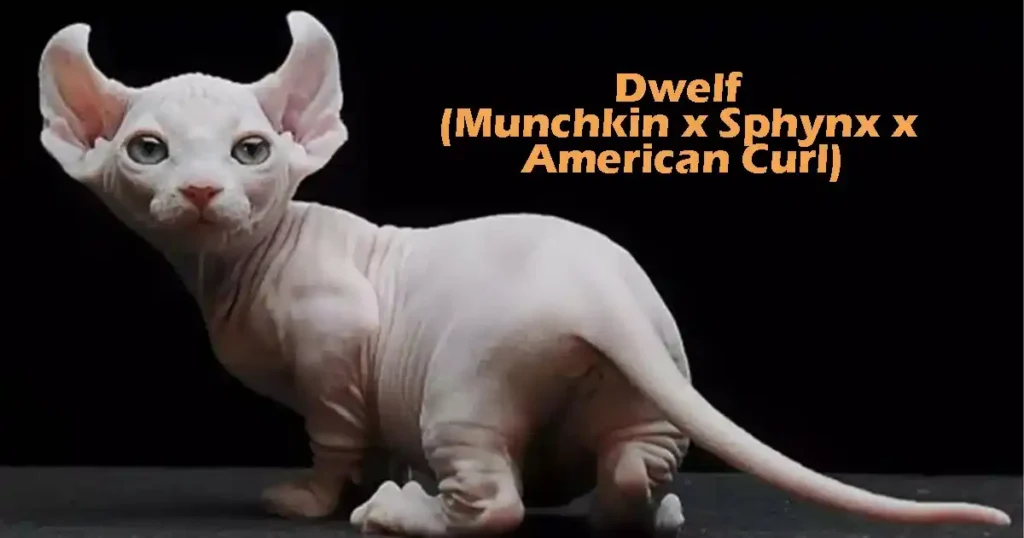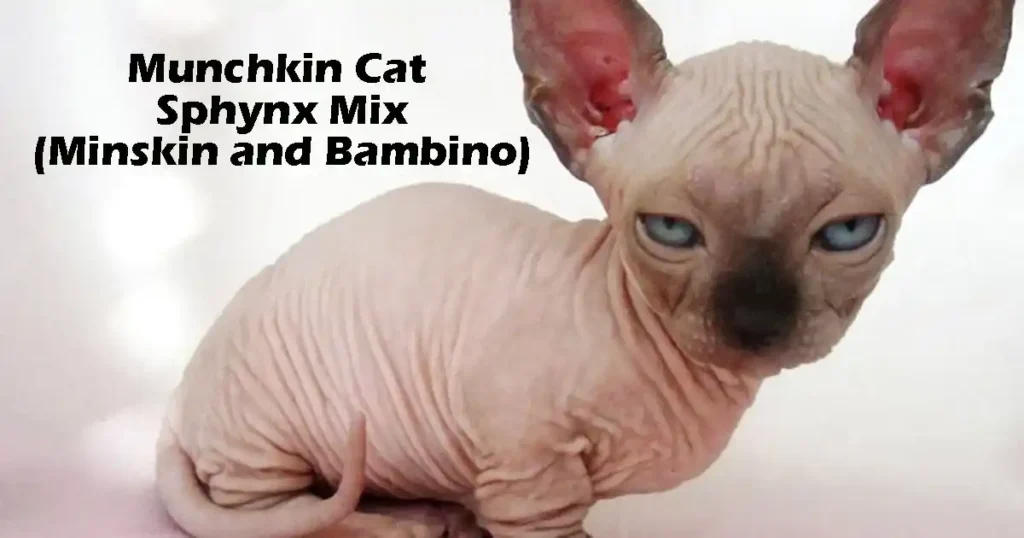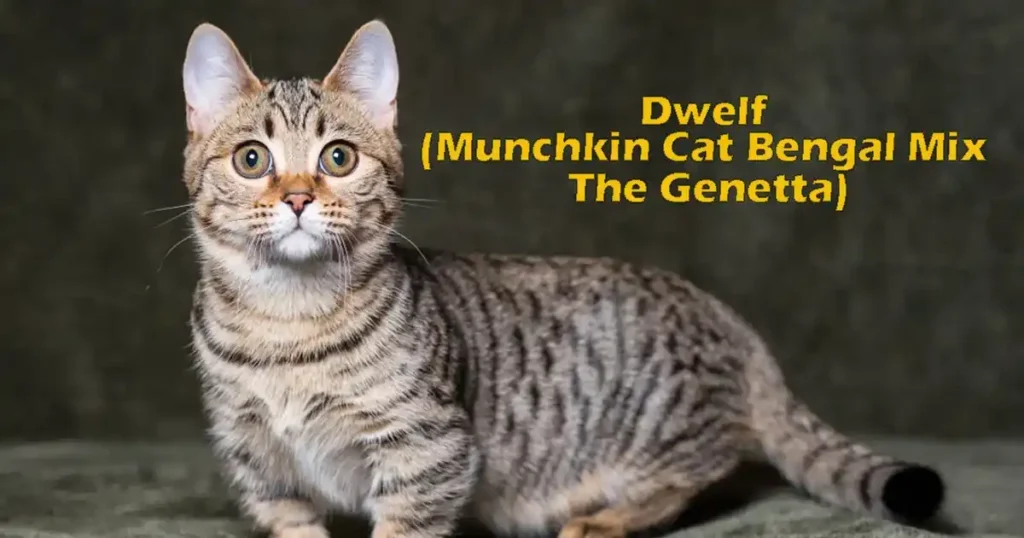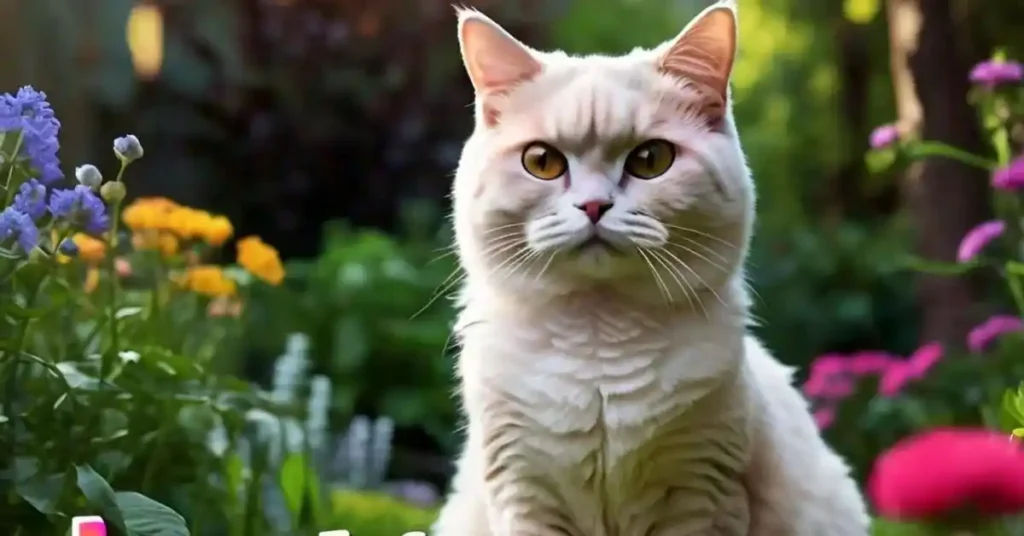The Dwelf Munchkin cat is a fascinating hybrid feline breed combining three standout features: short legs, a hairless body, and curled ears. This breed results from crossing three distinct breeds: the Munchkin, known for its short legs; the Sphynx recognized for its hairlessness; and the American Curl, famous for its curled ears.
The Dwelf Munchkin cat is a unique and relatively new breed, known for its distinctive appearance and playful personality. This breed is a cross between three different breeds: the Munchkin, Sphynx, and American Curl. Here’s an overview of the Dwelf Munchkin cat, including its characteristics, care requirements, and health considerations.
While its lack of fur is inherited from the Sphynx, its short legs come from the Munchkin lineage, and its distinctive ear shape is a result of the American Curl influence. Despite its unconventional look, the Dwelf Munchkin is known for being energetic, affectionate, and social, making it an engaging companion for families and individuals alike.
Understanding the Fascinating World of Munchkin and Dwelf Cats
If you’re a cat enthusiast, you might have come across some unique breeds like the Munchkin cat and the Dwelf cat. Both of these cats have distinctive appearances and personalities that make them stand out from the more common breeds.
But what exactly is a Munchkin cat, and how does it differ from other cats? The Munchkin cat breed is known for its short legs, which is the result of a genetic mutation called Munchkin dwarfism. This quirky feature gives them a playful and energetic nature that makes them a favorite among cat lovers.
But what about the Dwelf cat? A cross between the Sphynx and Munchkin breeds, the Dwelf cat inherits the short legs of the Munchkin and the hairless coat of the Sphynx. This combination creates a distinctive appearance and unique personality. Some may even call them “hairless dwarf cats,” due to their short stature and lack of fur.
How do Dwelf cats interact with other pets
Dwelf cats generally interact well with other pets, including both cats and dogs, when introduced properly. Their sociable and friendly nature allows them to adapt to multi-pet households12. Here are some key points about Dwelf cats’ interactions with other pets:
- Friendly disposition: Dwelf cats are typically friendly towards other animals, which helps foster positive relationships.
- Proper introduction: It’s essential to introduce Dwelf cats to other pets slowly and carefully, allowing time for adjustment.
- Playful nature: Some Dwelf cats may even play with the family dog, showcasing their adaptability.
- Multi-pet households: Their curious and sociable temperament enables them to adapt well to homes with multiple pets.
- Monitoring: Initially, it’s important to supervise interactions between Dwelf cats and other pets to ensure a harmonious environment.
- Escape options: Providing a cat tree or other elevated spaces allows the Dwelf cat to retreat if needed.
- Non-aggressive tendencies: Dwelf cats generally do not harbor aggression towards other pets, making coexistence easier.
While Dwelf cats are generally compatible with other pets, it’s important to remember that each cat has its own personality. Patience and proper introductions are key to ensuring successful interactions between Dwelf cats and other household pets.
The Costs of Owning a Munchkin or Dwelf Cat
Before considering bringing one of these adorable cats into your home, it’s essential to understand the costs. So, how much do Munchkin cats cost? The price can vary depending on factors like location, breeder, and whether the cat is a purebred or a mix.
On average, you might expect to pay anywhere from $500 to $2,000 for a Munchkin kitten, with rarer colors like the beige Munchkin cat potentially costing more. As for the Dwelf cat price, these unique cats tend to be on the more expensive side due to their rarity, with prices ranging from $1,000 to $3,000.
Personality Characteristics of Munchkin Dwelf Cats
What is a standard Munchkin cat? Generally, these cats are friendly, playful, and energetic, with a love for attention. Their short legs make them look different, but their playful nature and curiosity are what most people love about them.
But, is it cruel to have a Munchkin cat? While Munchkin cats are generally healthy, their short legs can sometimes lead to joint problems, so it’s essential to keep an eye on their health as they age.
On the other hand, the Dwelf cat is known for its affectionate and social personality. Dwelf cats tend to have a playful nature and love to be the center of attention. Dwelf cats are also known for being quite intelligent, which makes them easier to train. However, they can sometimes be a bit more sensitive due to their lack of fur and unique build.
Dwelf Cat: Info, Pictures, Temperament & Traits
The Dwelf cat is a unique and relatively new breed that combines characteristics from the Sphynx, Munchkin, and American Curl cats. Here’s a profile of this distinctive feline:
- Height: 6-7 inches
- Weight: 4-9 pounds
- Lifespan: 12-15 years
- Hairless or nearly hairless body
- Short legs
- Curled ears
- Large, expressive eyes
- Wrinkled skin, especially on legs, shoulders, and forehead
- Muscular, compact build
- Whip-like tail
Temperament and Personality
Dwelf cats are characterized by their:
- Playful and energetic nature
- High intelligence and curiosity
- Strong affection for their human family members
- Sociable disposition, often compared to small dogs
- Need for attention and interaction
- Difficulty adapting to change
These cats form strong bonds with their owners and may experience separation anxiety when left alone for extended periods.
Care Requirements
Grooming:
- Regular bathing to manage skin oils
- Gentle wiping with a damp cloth between baths
- Nail trimming and ear cleaning
Health Considerations:
- Susceptible to sunburn and cold temperatures
- May require feline sunscreen for outdoor exposure
- Prone to genetic health issues due to their breeding
Living Environment:
- Adapt well to various living situations, including apartments
- Prefer indoor living due to skin sensitivity
- Thrive in homes where they receive plenty of attention and companionship
Interaction with Family and Other Pets
Dwelf cats generally:
- Get along well with children when properly introduced
- Can be compatible with other pets, including dogs
- Need supervision during initial introductions to other animals
- Require mental stimulation through interactive toys and play
While Dwelf cats are charming and affectionate companions, potential owners should be aware of the controversy surrounding their breeding due to potential health issues related to their genetic makeup.
Are Munchkin and Dwelf Cats the Right Pet for You?
When considering a Munchkin cat or Dwelf cat, it’s important to ask yourself, is a Munchkin cat a good pet? These cats are generally affectionate and well-suited for families or individuals who can give them the attention they need.
But, are Munchkin cats prone to defects or health issues? While the Munchkin breed does have some inherent health risks, such as joint problems, most cats can live long, happy lives with proper care. If you’re considering purchasing a Munchkin dwarf cat or a Dwelf cat, make sure to research reputable breeders who prioritize the health and wellbeing of their cats.
Key Points to Consider When Choosing Between Munchkin and Dwelf Cats
- The Munchkin cat is known for its short legs, while the Dwelf cat combines this with a hairless coat.
- Munchkin cats tend to be more affordable, with prices ranging from $500 to $2,000.
- Dwelf cats are rarer and more expensive, with prices ranging from $1,000 to $3,000.
- Both breeds require regular grooming and attention, but Dwelf cats may need more specialized care due to their lack of fur.
- Always ensure you’re buying from a reputable breeder who prioritizes health and temperament.
History of the Dwelf Munchkin Cat
The Dwelf cat is a relatively new breed, emerging in the United States within the last two decades. Created by combining the Munchkin, Sphynx, and American Curl breeds, the Dwelf was first introduced to the public in 2008 by a breeder in Arkansas.
This experimental breed was developed through selective breeding to showcase a unique combination of physical traits.

Temperament of Dwelf Munchkin Cat
Dwelf cats are known for their social, affectionate, and intelligent nature. They tend to form strong bonds with their families and are often described as playful and engaging. However, they can be sensitive to changes in their environment and may experience separation anxiety if left alone for long periods
- Weight: Typically, Dwelf cats weigh between 4 to 7 pounds
- Lifespan: They generally have a lifespan of about 8 to 12 years
- Temperament: Known for their affectionate and playful nature, Dwelfs are highly sociable and enjoy being around people. They are often described as having dog-like qualities, forming strong bonds with their owners and getting along well with children and other pets.
Physical Characteristics
The Dwelf Munchkin’s physical characteristics include a hairless or nearly hairless coat, which requires regular grooming to maintain skin health. Their short legs, a defining feature, give them a unique gait, while their curled ears add to their whimsical appearance.
| Feature | Description |
|---|---|
| Size | Small to medium, typically weighing 4-9 pounds. |
| Coat | Hairless, with soft, warm, peach-like skin. |
| Ears | Curled ears that give them a distinct “elf-like” appearance. |
| Legs | Short legs, a signature feature inherited from the Munchkin breed. |
| Temperament | Friendly, playful, and highly affectionate; they thrive on human interaction. |
| Lifespan | 12-15 years on average, with proper care and attention. |
Typically small, these cats weigh between 4-9 pounds and stand about 6-7 inches tall. They come in various skin colors, such as pink, beige, and grey, but may require additional care due to their sensitivity to temperature extremes and potential skin issues.
Despite being relatively healthy, Dwelf Munchkins can face genetic health concerns inherited from their parent breeds, including joint problems and skin conditions.
Coat and Colors
While Dwelfs are primarily hairless, they come in various skin colors and patterns. Their skin may include solid, tabby, or spotted variations. Regular bathing is essential to remove excess oils and debris, and their lack of fur means that they require protection from extreme temperatures.
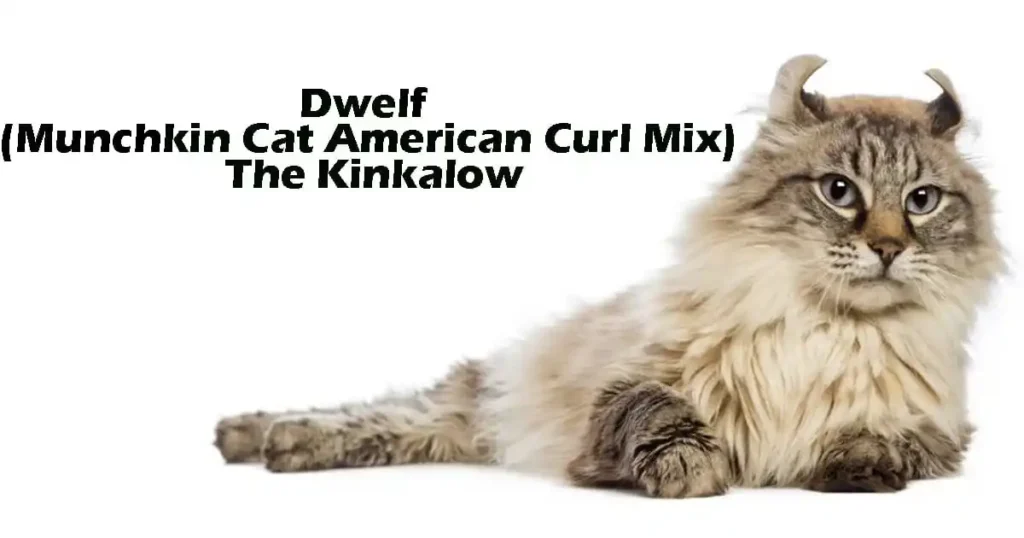
Personality and Temperament
Dwelf Munchkin cats are known for their sociable, friendly, and affectionate nature. Here’s a closer look at their personality traits. Dwelf Munchkins are known for their sociable and affectionate nature, often described as dog-like in their loyalty. They thrive on human interaction and are highly intelligent, making them playful and curious pets.
- Social butterflies: Dwelf cats enjoy spending time with people and other pets.
- Intelligent and curious: These cats are quick learners and love exploring their surroundings.
- Affectionate companions: They often form deep bonds with their families and love cuddling.
Care and Maintenance for Dwelf Cats
1. Skin Care
- Frequent cleaning: Since they lack fur, their skin is prone to oil buildup and requires regular cleaning to prevent irritation.
- Moisturize occasionally: Use pet-safe moisturizers to keep their skin healthy, especially in dry environments.
2. Temperature Regulation
- Keep them warm: Without fur, Dwelf cats are sensitive to temperature changes. Provide warm bedding and keep them indoors.
3. Nutrition
- High-quality diet: Feed them a balanced, protein-rich diet to maintain their energy and skin health.
4. Grooming
- Regular ear cleaning is crucial to avoid wax buildup, particularly given their curled ear shape.
- Bathing: Dwelfs need regular baths, ideally every 1-2 weeks, to keep their skin clean and healthy.
- Ear Cleaning: Frequent ear cleaning is necessary to prevent infections.
Common Health Issues
While generally healthy, Dwelf Munchkin cats may be prone to:
- Joint issues: Due to their short legs, they can experience joint discomfort over time.
- Skin conditions: Hairlessness increases the risk of sunburn and irritation.
- Spinal problems: Inherited from the Munchkin breed, these can occur but are not guaranteed.
Health Considerations
- Common Issues: Includes lordosis (spinal curvature), pectus excavatum (chest deformity), and ear infections. They may also suffer from degenerative joint diseases and heart conditions like Hypertrophic Cardiomyopathy (HCM).
- Lifespan: Generally 12-15 years with proper care.
- Feeding: A high-quality, balanced diet is essential. Dwelfs may require more frequent feedings due to their higher metabolism.
Temperature Sensitivity
- Protection: Due to their hairlessness, Dwelfs are sensitive to temperature extremes and may need additional warmth during colder months and protection from sun exposure.
Socialization and Exercise
Dwelf cats need regular exercise to stay healthy and happy. Interactive toys and playtime are important for their physical and mental well-being. Early socialization is crucial to ensure they grow up well-adjusted and friendly. Introducing them to various environments and social situations can help prevent behavioral issues.
Breeding and Adoption
Responsible breeding is essential to avoid genetic health issues. Potential breeders should prioritize the health and well-being of their cats. When adopting a Dwelf, choose a reputable breeder or rescue organization to ensure the cat is healthy and well-socialized.
- Price Range: Typically between $2,000 to $3,500, depending on the breeder and the cat’s pedigree.
Pros and Cons of Owning a Dwelf
- Unique Appearance: Their hairless, short-legged, and curled-eared look makes them stand out.
- Affectionate Nature: Known for their loving and playful personality.
- Low Maintenance Coat: Minimal shedding, which is beneficial for allergy sufferers.
- Special Care Requirements: Regular grooming and protection from temperature extremes.
- Health Issues: Potential for genetic health problems due to their unique breeding.
- Cost: High acquisition and maintenance costs.
FAQs
Are Dwelf Munchkin cats hypoallergenic?
No, despite being hairless, they are not completely hypoallergenic. People allergic to cat dander may still experience reactions.
How much does a Dwelf Munchkin cat cost?
Due to their rarity, prices typically range from $2,000 to $3,500, depending on the breeder and lineage.
Are they suitable for families with children?
Yes! Dwelf cats are social and patient, making them great companions for families with children.
Do Dwelf cats get along with other pets?
Absolutely. Their friendly nature allows them to coexist well with other cats and even dogs.
Conclusion
The Dwelf Munchkin cat represents a fascinating blend of unique traits and endearing personality characteristics. While their appearance and playful demeanor make them an appealing choice for many, potential owners should be prepared for the specific care needs and health considerations associated with this breed. With proper attention and care, a Dwelf cat can be a rewarding and cherished companion.
